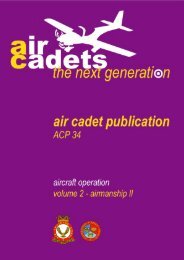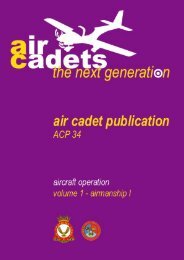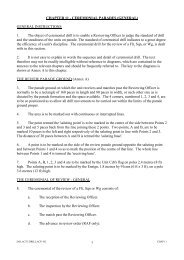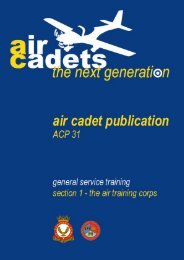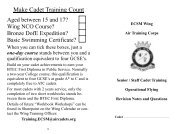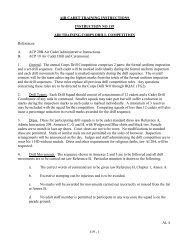Leading Cadet ECSM Wing Revision Guide - 967 Air Cadets
Leading Cadet ECSM Wing Revision Guide - 967 Air Cadets
Leading Cadet ECSM Wing Revision Guide - 967 Air Cadets
Create successful ePaper yourself
Turn your PDF publications into a flip-book with our unique Google optimized e-Paper software.
Upper Winds<br />
Depressions move under the influence of:<br />
The upper wind is responsible for the general<br />
movement of a depression.<br />
This diagram shows isobars for both the upper<br />
a) Lower winds. b) Warm fronts.<br />
c) Cold fronts. d) Upper winds.<br />
Upper winds are generally responsible for:<br />
a) The strength of the surface wind.<br />
b) Poor weather.<br />
c) Fine weather.<br />
d) Movement of a epression.<br />
In the diagram above left, the dotted lines represent the<br />
upper wind and the solid lines the lower wind. If you<br />
stood at Y with your back to the lower wind and the upper<br />
wind is moving from left to right:<br />
a) You'll feel a warm wind in your face.<br />
b) The weather is likely to improve.<br />
c) The weather is likely to deteriorate.<br />
d) There will be no change in the weather for a while.<br />
HOW TO USE THIS BOOK<br />
This manual contains essential knowledge<br />
and key revision points for the three <strong>Leading</strong><br />
<strong>Cadet</strong> subjects, Principles of Flight, <strong>Air</strong>manship<br />
and Basic Navigation.<br />
You may be sitting all three subjects together,<br />
or you may be sitting them separately. Ensure<br />
you know which subjects you will be sitting<br />
before each examination and retain this book<br />
until you have successfully passed all three<br />
subjects.<br />
Chapter 1<br />
Principles of Flight<br />
Contents<br />
Lift and Weight<br />
Newton’s Law<br />
Bernoulli’s Principle<br />
Lift<br />
Factors Affecting Lift<br />
Straight and Level Flight<br />
winds (dotted) and lower winds (solid lines). If<br />
you are standing at position ‘Y’ with your back to<br />
the lower wind, the upper wind is moving from<br />
west to east , the depression has not reached you<br />
yet and the weather is likely to deteriorate.<br />
Anticyclones<br />
Anticyclones are regions of high pressure with<br />
widely spaced isobars and light winds. In general<br />
they are stable, slow-moving systems, consisting<br />
of warm, dry air, bringing long periods of fine<br />
clear weather.<br />
Clouds<br />
Clouds are named according to both their shape<br />
and their height. There are three main types of<br />
cloud:<br />
Cirrus - found only at high levels and composed<br />
of ice crystals. (Cirrus means thread or hair.)<br />
Cumulus - a lumpy or heaped cloud.<br />
Stratus - a featureless layer cloud.<br />
Dependant upon their height, clouds may be prefixed<br />
with :<br />
An anticyclone is:<br />
a) An area of low pressure.<br />
b) An area of high pressure.<br />
c) A depression.<br />
d) An area between two areas of high pressure.<br />
Generally an area of high pressure will tend to bring:<br />
a) Fast moving wet weather systems.<br />
b) Fast moving fine weather systems.<br />
c) Long periods of fine weather.<br />
d) Long periods of poor weather.<br />
Stratus is what type of cloud?<br />
a) Lumpy or heaped. b) Hair-like.<br />
c) Featureless layer. d) Thread-like.<br />
Cumulus is what type of cloud?<br />
a) Lumpy or heaped. b) Hair-like.<br />
c) Featureless layer. d) Thread-like.<br />
Cirrus is what type of cloud?<br />
a) Lumpy. b) Heaped.<br />
c) Hair or thread-like. d) Featureless layer.<br />
Cloud names may have a prefix which indicates the height<br />
of the cloud base. Which of these indicates a cloud with a<br />
base at medium level?<br />
a) Nimbo. b) Cirro. c) Alto. d) Strato.<br />
When alto is used as a prefix in a name of a cloud, that<br />
cloud may be found at:<br />
Read each page, then read the associated<br />
questions. Underline or highlight the correct<br />
answer. Before the examination date, check<br />
with your instructor to ensure that your chosen<br />
answers are the correct ones. Revise these<br />
questions and answers as they will constitute<br />
a very high proportion of the actual examination<br />
questions.<br />
Sqn Ldr P Twose<br />
Training Officer<br />
<strong>ECSM</strong> <strong>Wing</strong><br />
<strong>Leading</strong> <strong>Cadet</strong> Training<br />
Contents<br />
Principles of Flight Page 3<br />
Revised May 08<br />
<strong>Air</strong>manship Page 16<br />
Revised Mar 08<br />
Chapter 2<br />
Chapter 3<br />
Chapter 4<br />
Chapter 5<br />
Thrust and Drag<br />
Thrust<br />
Drag<br />
Variation with <strong>Air</strong>speed<br />
Straight and Level Flight<br />
Stability and Control<br />
Stability<br />
Dihedral<br />
Anhedral<br />
The Pilot’s Controls<br />
Trim Tabs<br />
Flaps<br />
Slats<br />
Stalling<br />
Stalling Speed<br />
Gliding<br />
Gliding (balance of forces)<br />
Gliding Angle<br />
<strong>Air</strong>brakes<br />
Cirro - high clouds (5,500m to 11,000m)<br />
e.g. cirrocumulus, cirrostratus.<br />
Alto - medium level (2000m to 5,500m)<br />
e.g. altocumulus, altostratus.<br />
Clouds with no prefix have a base below 2000m,<br />
e.g. cumulus, cumulonimbus, stratus and stratocumulus.<br />
a) Any level. b) Low level.<br />
c) Medium level. d) High level.<br />
Which of these would only be found at high level?<br />
a) Stratocumulus. b) Altocumulus.<br />
c) Altostratus. d) Cirrostratus.<br />
High level cloud names begin with the prefix:<br />
a) Strato b) Alto<br />
c) Nimbo d) Cirro<br />
Basic Navigation Page 26<br />
Revised Apr 07<br />
Amended Mar 08<br />
Chapter 6<br />
The Helicopter<br />
Torque Reaction<br />
Flying Controls<br />
Collective Pitch Control<br />
The Hand Throttle<br />
Cyclic Pitch Control<br />
Tail Rotor Control<br />
38<br />
3



